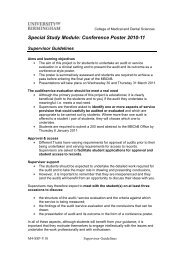Contents - College of Medical and Dental Sciences - University of ...
Contents - College of Medical and Dental Sciences - University of ...
Contents - College of Medical and Dental Sciences - University of ...
You also want an ePaper? Increase the reach of your titles
YUMPU automatically turns print PDFs into web optimized ePapers that Google loves.
The 11 th International Workshop on KSHV & Related Agents, Birmingham, UK<br />
Poster Session Abstract P13<br />
IDENTIFICATION OF NOVEL CONSERVED GAMMAHERPESVIRUS MICRORNAS<br />
Nicole Walz , Thomas Christalla <strong>and</strong> Adam Grundh<strong>of</strong>f<br />
Heinrich-Pette Institute for Experimental Virology <strong>and</strong> Immunology, D-20251 Hamburg,<br />
Germany<br />
Abstract<br />
microRNAs (miRNAs) are small (~22 nt.), non-coding RNA molecules which posttranscriptionally<br />
regulate mRNA expression <strong>and</strong> play important roles in the regulation <strong>of</strong><br />
diverse cellular processes. The current release <strong>of</strong> the miRNA database (miRBase) lists a<br />
total <strong>of</strong> 132 known viral miRNAs, the vast majority <strong>of</strong> which are encoded by members <strong>of</strong><br />
the herpesvirus family. While the propensity to encode miRNAs appears to be a<br />
conserved feature <strong>of</strong> many herpesviruses, the miRNAs themselves show little<br />
conservation: with the exception <strong>of</strong> 7 miRNAs known to be shared between Epstein-Barr<br />
Virus (EBV) <strong>and</strong> its close relative Rhesus Lymphocryptovirus (rLCV), all other herpesvirus<br />
miRNAs appear unrelated in sequence. We have recently developped VMir, a<br />
computational ab initio prediction method to identify viral miRNAs, <strong>and</strong> have employed<br />
the program to identify miRNAs in SV40, KSHV <strong>and</strong> EBV. We have modified the algorithm<br />
to allow consideration <strong>of</strong> evolutionary conservation <strong>and</strong> conducted an extended analysis<br />
<strong>of</strong> the herpesvirus family. We were able to identify <strong>and</strong> experimentally verify 2 novel<br />
EBV- <strong>and</strong> 17 novel rLCV-encoded miRNAs; with a total <strong>of</strong> 33 miRNAs rLCV is now the<br />
virus with the highest number <strong>of</strong> known miRNAs. In contrast, we have found little<br />
evidence for the existence <strong>of</strong> hitherto unknown conserved miRNAs shared by other<br />
herpesviruses, including KSHV <strong>and</strong> the closely related Rhesus Rhadinovirus (RRV). While<br />
EBV <strong>and</strong> rLCV thus share even more miRNAs than previously thought, our results<br />
underline the notion that, in contrast to their cellular counterparts, viral miRNAs show an<br />
almost total lack <strong>of</strong> sequence conservation.<br />
Presenting author Email: Adam.Grundh<strong>of</strong>f@hpi.uni-hamburg.de<br />
110















